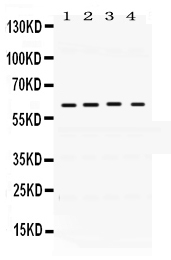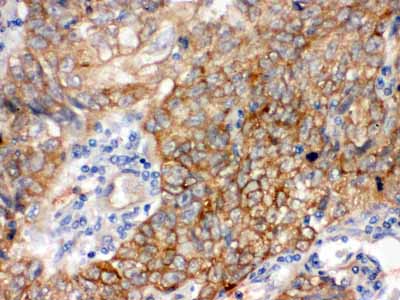Anti-Bag3 Picoband Antibody
- SPECIFICATION
- CITATIONS
- PROTOCOLS
- BACKGROUND

Application
| WB, IHC-P |
|---|---|
| Primary Accession | O95817 |
| Host | Rabbit |
| Reactivity | Human, Rat |
| Clonality | Polyclonal |
| Format | Lyophilized |
| Description | Rabbit IgG polyclonal antibody for BAG family molecular chaperone regulator 3(BAG3) detection. Tested with WB, IHC-P in Human;Rat. |
| Reconstitution | Add 0.2ml of distilled water will yield a concentration of 500ug/ml. |
| Gene ID | 9531 |
|---|---|
| Other Names | BAG family molecular chaperone regulator 3, BAG-3, Bcl-2-associated athanogene 3, Bcl-2-binding protein Bis, Docking protein CAIR-1, BAG3, BIS |
| Calculated MW | 61595 MW KDa |
| Application Details | Immunohistochemistry(Paraffin-embedded Section), 0.5-1 µg/ml, Human, By Heat Western blot, 0.1-0.5 µg/ml, Human, Rat |
| Protein Name | BAG family molecular chaperone regulator 3 |
| Contents | Each vial contains 5mg BSA, 0.9mg NaCl, 0.2mg Na2HPO4, 0.05mg NaN3. |
| Immunogen | E.coli-derived human Bag3 recombinant protein (Position: H100-N561). Human Bag3 shares 84.1% amino acid (aa) sequence identity with mouse Bag3. |
| Purification | Immunogen affinity purified. |
| Cross Reactivity | No cross reactivity with other proteins. |
| Storage | At -20˚C for one year. After r˚Constitution, at 4˚C for one month. It˚Can also be aliquotted and stored frozen at -20˚C for a longer time.Avoid repeated freezing and thawing. |
| Name | BAG3 |
|---|---|
| Synonyms | BIS |
| Function | Co-chaperone and adapter protein that connects different classes of molecular chaperones including heat shock proteins 70 (HSP70s), e.g. HSPA1A/HSP70 or HSPA8/HSC70, and small heat shock proteins (sHSPs), e.g. HSPB8 (PubMed:27884606, PubMed:30559338). Acts as a nucleotide-exchange factor (NEF) promoting the release of ADP from HSP70s, thereby triggering client protein release (PubMed:27884606, PubMed:30559338). Nucleotide release is mediated via BAG3 binding to the nucleotide-binding domain (NBD) of HSP70s, whereas client release is mediated via binding to the substrate-binding domain (SBD) (PubMed:27474739, PubMed:9873016). Has anti-apoptotic activity (PubMed:10597216). Plays a role in the HSF1 nucleocytoplasmic transport (PubMed:26159920). |
| Cellular Location | Nucleus. Cytoplasm. Note=Colocalizes with HSF1 to the nucleus upon heat stress (PubMed:26159920) |

Thousands of laboratories across the world have published research that depended on the performance of antibodies from Abcepta to advance their research. Check out links to articles that cite our products in major peer-reviewed journals, organized by research category.
info@abcepta.com, and receive a free "I Love Antibodies" mug.
Provided below are standard protocols that you may find useful for product applications.
Background
BAG family molecular chaperone regulator 3(BAG3) is a member of a conserved family of cyto-protective proteins that bind to and regulate Hsp70 family molecular chaperones. BAG3 mutations are responsible for familial dilated cardiomyopathy. BAG3 polymorphisms are also associated with sporadic forms of the disease together with HSPB7 locus. In muscle cells, BAG3 cooperates with the molecular chaperones Hsc70 and HspB8 to induce the degradation of mechanically damaged cytoskeleton components in lysosomes. This process is called chaperone-assisted selective autophagy (CASA) and is essential for maintaining muscle activity in flies, mice and men.
If you have used an Abcepta product and would like to share how it has performed, please click on the "Submit Review" button and provide the requested information. Our staff will examine and post your review and contact you if needed.
If you have any additional inquiries please email technical services at tech@abcepta.com.













 Foundational characteristics of cancer include proliferation, angiogenesis, migration, evasion of apoptosis, and cellular immortality. Find key markers for these cellular processes and antibodies to detect them.
Foundational characteristics of cancer include proliferation, angiogenesis, migration, evasion of apoptosis, and cellular immortality. Find key markers for these cellular processes and antibodies to detect them. The SUMOplot™ Analysis Program predicts and scores sumoylation sites in your protein. SUMOylation is a post-translational modification involved in various cellular processes, such as nuclear-cytosolic transport, transcriptional regulation, apoptosis, protein stability, response to stress, and progression through the cell cycle.
The SUMOplot™ Analysis Program predicts and scores sumoylation sites in your protein. SUMOylation is a post-translational modification involved in various cellular processes, such as nuclear-cytosolic transport, transcriptional regulation, apoptosis, protein stability, response to stress, and progression through the cell cycle. The Autophagy Receptor Motif Plotter predicts and scores autophagy receptor binding sites in your protein. Identifying proteins connected to this pathway is critical to understanding the role of autophagy in physiological as well as pathological processes such as development, differentiation, neurodegenerative diseases, stress, infection, and cancer.
The Autophagy Receptor Motif Plotter predicts and scores autophagy receptor binding sites in your protein. Identifying proteins connected to this pathway is critical to understanding the role of autophagy in physiological as well as pathological processes such as development, differentiation, neurodegenerative diseases, stress, infection, and cancer.



